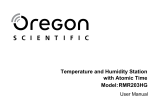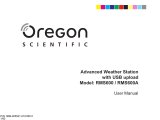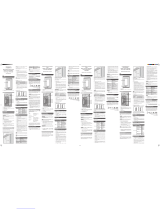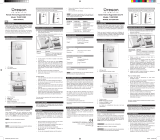
Remote Thermo-Hygro Sensor
Model: THGN132N
USER MANUAL
EN
OVERVIEW
FRONT VIEW (FIG. 1)
1
1. LED status indicator: blinks when transmitting a
reading
BACK VIEW (FIG. 2)
1
2
3
4
1. Wall mount hole
2. Battery compartment
3. RESET: Reset unit to default settings
4. Channel Switch
GETTING STARTED
SENSOR SET UP
1. Slide open the battery door.
2. Slide channel switch to select a channel (1, 2, 3). Ensure
you use a different channel for each sensor.
3. Insert the battery, matching the polarities (+ / -). See FIG
2.
4. Press
RESET after each battery change.
5. Close the battery door.
NOTE Install battery in the remote sensor before the main
unit.
6. Initiate a sensor search on the main unit to start receiving
temperature / humidity data from the sensor.
7. Secure the sensor in the desired location using the wall
mount or table stand.
For best results:
• Place the sensor within 30 m (100 ft) of the main unit.
• Place the sensor out of direct sunlight and moisture.
• Position the sensor so that it faces the main (indoor)
unit, minimizing obstructions such as doors, walls and
furniture.
• Place the sensor in a location with a clear view to the
sky, away from metallic / electronic objects.
• Position the sensor close to the main unit during cold
winter months as below-freezing temperatures may
affect battery performance and signal transmission.
TIP The transmission range may vary depending on many
factors. You may need to experiment with various locations
to get the best results.
NOTE Use alkaline batteries for longer usage and consumer
grade lithium batteries in temperatures below freezing.
CHANGING CHANNELS
To change channels once channel has been assigned:
1. Slide channel switch to desired channel.
2. Press RESET.
3. Initiate a sensor search on the main unit to start
receiving temperature / humidity data from the sensor.
RESET
Press RESET to return to the default settings.
TROUBLE SHOOTING
PROBLEM SYMPTOM REMEDY
Remote
sensor
Abnormal /
strange readings
Press RESET
Cannot locate
remote sensor
Check battery
Check location
Cannot change
channel
Check sensors.
Only one sensor
is working
Data does not
match main unit
Initiate a manual
sensor search
PRECAUTIONS
• Do not subject the unit to excessive force, shock, dust,
temperature or humidity
• Do not cover the ventilation holes with any items such s
newspapers, curtains etc.
• Do not immerse the unit in water. If you spill liquid over
it, dry it immediately with a soft, lint-free cloth.
• Do not clean the unit with abrasive or corrosive
materials.
• Do not tamper with the unit ’s internal components. This
invalidates the warranty.
• Only use fresh batteries. Do not mix new and old
batteries.
• Images shown in this manual may differ from the actual
display.
• When disposing of this product, ensure it is collected
separately for special treatment.
• Placement of this product on certain types of wood
may result in damage to its finish for which Oregon
Scientific will not be responsible. Consult the furniture
manufacturer's care instructions for information.
• The contents of this manual may not be reproduced
without the permission of the manufacturer.
• Do not dispose old batteries as unsorted municipal
waste. Collection of such waste separately for special
treatment is necessary.
• Please note that some units are equipped with a
battery safety strip. Remove the strip from the battery
compartment before first use.
NOTE The technical specifications for this product and the
contents of the user manual are subject to change without
notice.
SPECIFICATIONS
TYPE DESCRIPTION
REMOTE UNIT
L x W x H
117
x 80 x 171 mm
(4.78 x 3.27 x 6.98 in)
Weight
241 g (8.5 oz) without battery
Temperature
range
-20°C to 60°C
(-4°F to 140°F)
Resolution 0.1°C (0.2°F)
Humidity range 25% - 95%
Humidity
resolution
1%
Signal frequency 433 MHz
Transmission
range
30 m (98 ft) unobstructed
No. of channels 3
Power 1 x UM-3 (AA) 1.5 V batteries
ABOUT OREGON SCIENTIFIC
Visit our website (www.oregonscientific.com) to learn more
about Oregon Scientific products. If you’re in the US and
would like to contact our Customer Care department directly,
please visit: www2.oregonscientific.com/service/support
OR
Call 1-800-853-8883.
For international inquiries, please visit:
www2.oregonscientific.com/about/international
INDUSTRY CANADA STATEMENT
Operation is subject to the following two conditions:
(1) this device may not cause interference, and
(2) this device must accept any interference, including
interference that may cause undesired operation of
the device.
IC number: 3277A-THGN132N
EU-DECLARATION OF CONFORMITY
Hereby, Oregon Scientific, declares that this Remote
Thermo-Hygro Sensor (model:
THGN132N) is in compliance
with the essential requirements and other relevant
provisions of Directive 1999/5/EC. A copy of the signed and
dated Declaration of Conformity is available on request via
our Oregon Scientific Customer Service.
COUNTRIES RTTE APPROVED COMPLIED
All EU countries, Switzerland CH
and Norway N
FCC STATEMENT
This device complies with Part 15 of the FCC Rules.
Operation is subject to the following two conditions: (1) This
device may not cause harmful interference, and (2) This
device must accept any interference received, including
interference that may cause undesired operation.
WARNING Changes or modifications not expressly
approved by the party responsible for compliance could
void the user’s authority to operate the equipment.
NOTE This equipment has been tested and found to
comply with the limits for a Class B digital device, pursuant
to Part 15 of the FCC Rules. These limits are designed to
provide reasonable protection against harmful interference
in a residential installation.
This equipment generates, uses and can radiate radio
frequency energy and, if not installed and used in accordance
with the instructions, may cause harmful interference to
radio communications. However, there is no guarantee
that interference will not occur in a particular installation.
If this equipment does cause harmful interference to radio
or television reception, which can be determined by turning
the equipment off and on, the user is encouraged to try to
correct the interference by one or more of the following
measures:
• Reorient or relocate the receiving antenna.
• Increase the separation between the equipment and
receiver.
• Connect the equipment into an outlet on a circuit different
from that to which the receiver is connected.
• Consult the dealer or an experienced radio / TV technician for
help.
DECLARATION OF CONFORMITY
The following information is not to be used as contact for
support or sales. Please call our customer service number
(listed on our website at www.oregonscientific.com), or on
the warranty card for this product) for all inquiries instead.
We
Name: Oregon Scientific, Inc.
Address: 19861 SW 95
th
Ave.,Tualatin,
Oregon 97062 USA
Telephone No.: 1-800-853-8883
declare that the product
Product No.: THGN132N
Product Name: Remote Thermo-Hygro Sensor
Manufacturer: IDT Technology Limited
Address: Block C, 9/F, Kaiser Estate,
Phase 1, 41 Man Yue St., Hung
Hom, Kowloon,
Hong Kong
is in conformity with Part 15 of the FCC Rules. Operation is
subject to the following two conditions: 1) This device may
not cause harmful interference. 2) This device must accept
any interference received, including interference that may
cause undesired operation.
Sensore igrotermico remoto
Modello: THGN132N
MANUALE UTENTE
IT
PANORAMICA
PARTE ANERIORE (FIG. 1)
1
1. Indicatore di stato del LED: lampeggia quando viene
trasmessa una lettura
PARTE POSTERIORE (FIG. 2)
1
2
3
4
1. Foro di montaggio alla parete
2. Vano batteria
3. RESET: Reimposta nell’unità le impostazioni
predefinite
4. Commutatore canale
UTILIZZO
IMPOSTAZIONE DEL SENSORE
1. Aprire il coperchio della batteria facendolo scorrere.
2. Utilizzare il commutatore di canale per selezionare
un canale (1, 2, 3). Verificare di utilizzare un canale
diverso per ciascun sensore.
3. Inserire la batteria facendo corrispondere i poli (+ / -).
Vedere la FIG 2.
4. Premere
RESET dopo ogni sostituzione di batteria.
5. Chiudere il coperchio della batteria.
NOTA Installare la batteria nel sensore a distanza prima
dell’unità principale.
6. Iniziare una ricerca con in sensore nell’unità principale
per avviare la rilevazione dei dati sulla temperatura/
umidità dal sensore.
7. Verificare che il sensore sia posizionato correttamente
utilizzando il gancio alla parete o il supporto di
appoggio.
Per risultati migliori:
• Posizionare il sensore a una distanza inferiore a 30 m
(100 ft) dall’unità principale.
• Tenere il sensore lontano dalla luce diretta del sole e
umidità.
• Posizionare il sensore di fronte all’unità principale
(interna), riducendo le interferenze quali porte, pareti e
mobili.
• Posizionare il sensore in un luogo in cui sia possibile
vedere il cielo, lontano da oggetti metallici/elettronici.
• Posizionare il sensore vicino all’unità principale durante
i mesi invernali con temperature sotto lo zero che
potrebbero danneggiare le prestazioni della batteria e il
segnale di trasmissione.
SUGGERIMENTO Il campo di trasmissione può variare
in base a molti fattori. E possibile dover provare diverse
posizioni prima di ottenere i risultati migliori.
NOTA Utilizzare batterie alcaline in caso di uso prolungato
e batterie al litio in ambienti con temperature inferiori allo 0.
CAMBIO DEI CANALI
Per cambiare i canali dopo che un canale è stato
assegnato:
1. Posizionare l’apposito commutatore sul canale
desiderato.
2. Premere
RESET.
3. Iniziare una ricerca con il sensore nell’unità principale
per avviare il rilevamento di dati sulla temperatura/
umidità dal sensore.
FUNZIONE RESET
Premere RESET per ripristinare le impostazioni predefinite
dell’unità.
RISOLUZIONE DEI PROBLEMI
PROBLEMA SINTOMO SOLUZIONE
Sensore
remoto
Letture anormali /
strane
Premere RESET
Impossibile
localizzare
il sensore a
distanza
Controllare la batteria
Controllare la
posizione
Impossibile
cambiare canale
Controllare i sensori.
Un solo sensore è in
funzionamento
I dati non
corrispondono
all’unità principale
Iniziare una ricerca
del sensore manuale
PRECAUZIONI
Per utilizzare il prodotto in modo sicuro e corretto, leggere
queste avvertenze e tutto il manuale prima dell’uso.
• Utilizzare un panno morbido, leggermente inumidito. Non
utilizzare prodotti di pulizia abrasivi o corrosivi, in quanto
potrebbero causare danni. Non utilizzare mai i prodotti in
acqua calda né riporli se bagnati.
• Non sottoporre il prodotto a forza eccessiva, urti, polvere,
variazioni di temperatura o a umidità. Non esporre il
prodotto a luce solare diretta per lunghi periodi. Un simile
trattamento può comportare il malfunzionamento del
prodotto.
• Non manomettere i componenti interni. In questo modo si
invalida la garanzia del prodotto e si possono provocare
danni. L’unità principale non contiene componenti che
possono essere riparati dall’utente.
• Non graffiare il display LCD con oggetti duri in quanto si
potrebbero causare danni.
• Manipolare le batterie con attenzione.
• Togliere le batterie ogni volta che si prevede di lasciare
inutilizzato il prodotto per un lungo periodo di tempo.
• Al momento della sostituzione delle batterie, utilizzare
batterie nuove come indicato in questo manuale per
l’utente.
• Il prodotto è uno strumento di precisione. Non tentare
mai di aprirlo. Contattare il proprio rivenditore o il nostro
servizio clienti se il prodotto necessita di riparazioni.
• Non toccare il circuito elettrico esposto, poiché questo
può provocare scosse elettriche.
• Controllare tutte le funzioni più importanti se il prodotto
non è stato utilizzato per un lungo periodo di tempo.
Controllare e pulire l’apparecchio regolarmente. Far
controllare l’orologio presso un centro autorizzato una
volta all’anno.
• Al momento dello smaltimento di questo prodotto, agire
in conformità con i regolamenti locali sullo smaltimento
dei rifiuti.
• A causa di limitazioni di stampa, le immagini di questo
manuale possono differire dalla realtà.
• Il contenuto di questo manuale non può essere ristampato
senza l’autorizzazione del fabbricante.
NOTA Le specifiche tecniche del prodotto e il contenuto
del manuale per l’utente possono essere modificati senza
preavviso.
SPECIFICHE TECNICHE
TIPO DESCRIZIONE
UNITA’ REMOTA
Lung x Larg x Alt
117 x 80 x 171 mm
(4.78 x 3.27 x 6.98 in)
Peso
241 g (8.5 oz)
senza batteria
Intervallo
temperatura
da -20°C a 60°C
(da -4°F a 140°F)
Risoluzione 0.1°C (0.2°F)
Umidità 25% - 95%
Risoluzione umidità 1%
Frequenza segnale 433 MHz
Intervallo
trasmissione
30 m (98 ft) senza interferenze
N. di canali 3
Potenza Batterie: 1 x UM-3 (AA) 1,5 V
INFORMAZIONI SU OREGON SCIENTIFIC
Per avere maggiori informazioni sui nuovi prodotti
Oregon Scientific visita il nostro sito internet
www.oregonscientific.it
, dove potrai trovare tutte le
informazioni di cui hai bisogno.
Per ricerche di tipo internazionale puoi visitare invece il sito
www2.oregonscientific.com/about/international.asp
.
DICHIARAZIONE DI CONFORMITA’ UE
Oregon Scientific dichiara che questo prodotto (Modello
THGN132N) è conforme alla direttiva EMC 89/336/CE. Una
copia firmata e datata della Dichiarazione di Conformità
è disponibile, su richiesta, tramite il servizio clienti della
Oregon Scientific.
PAESI CONFORMI ALLA DIRETTIVA R&TTE
Tutti I Paesi Ue, Svizzera CH
E Norvegia N
Sonde thermo-hygrométrique sans fil
Modèle : THGN132N
MANUEL DE L’UTILISATEUR
FR
VUE D’ENSEMBLE
FACE AVANT (FIG 1)
1
1. Indicateur de statut par LED clignote lors de la
transmission d’un relevé
FACE ARRIERE ( FIG 2)
1
2
3
4
1. Trou de fixation murale
2. Compartiment des piles
3. RESET (REINITIALISER) : Réinitialise l’appareil aux
réglages par défaut
4. Interrupteur de canal
POUR COMMENCER
REGLAGE DE LA SONDE
1. Ouvrez le couvercle du compartiment des piles.
2. Positionnez l’interrupteur de canal pour sélectionner
un canal (1, 2, 3). Assurez-vous d’utiliser une chaîne
différente pour chaque sonde.
3. Insérez la pile, en respectant les polarités (+/-). Voir FIG
2.
4. Appuyer sur
RESET après chaque changement de
piles.
5. Fermez le couvercle du compartiment des piles.
REMARQUE Insérez la pile de la sonde sans fil avant
celles de l’appareil principal.
6. Lancez une recherche de sonde à partir de l’appareil
principal pour que la sonde transmette les données
relatives à la température / à l’humidité.
7. Sécurisez la sonde à l’emplacement choisi, en utilisant
la fixation murale ou le support de table.
Pour obtenir de meilleurs résultats :
• Positionnez la sonde à 30 m maximum (100 pieds) de
l’appareil principal.
• Ne placez pas la sonde directement face aux rayons du
soleil ou en contact avec des matières humides.
• Positionnez la sonde pour qu’elle soit face à l’appareil
principal (intérieur), en minimisant les obstacles tels que
porte, murs et meubles.
• Dirigez la sonde directement vers le ciel, éloignée des
objets métalliques / électroniques.
• Positionnez la sonde à proximité de l’appareil
principal pendant les mois d’hiver puisque le gel
peut endommager le fonctionnement des piles et la
transmission du signal.
ASTUCE La portée de transmission peut varier en fonction
de nombreux facteurs. Il peut être nécessaire d’essayer
plusieurs emplacements pour obtenir les meilleurs
résultats.
REMARQUE Utiliser des piles alcalines pour une plus
grande longévité et des piles au lithium en vente aux
particuliers pour des températures en dessous de 0 c.
CHANGEMENT DES CANAUX
Changer les canaux une fois un canal assigné :
1. Positionnez l’interrupteur de canal sur le canal désiré.
2. Appuyez sur
RESET.
3. Lancez une recherche de sonde à partir de l’appareil
principal pour que la sonde transmette les données
relatives à la température / à l’humidité.
REINITIALISATION
Appuyer sur RESET pour revenir aux réglages par défaut.
DEPANNAGE
PROBLEME SYMPTOME SOLUTION
Sonde sans
fil
Relevés anormaux
/ étranges
Appuyer sur
RESET
Impossible de
localiser la sonde
sans fil
Vérifier les
piles
Vérifier
l’emplacement
Impossible de
changer de canal
Vérifier les
sondes. Une
seule sonde
ne fonctionne
Les données ne
correspondent
pas à l’appareil
principal.
Lancer une
recherche
manuelle
PRECAUTIONS
• Ne pas soumettre le produit à une force excessive, au
choc, à la poussière, aux changements de température
ou à l’humidité.
• Ne pas couvrir les trous de ventilation avec des
journaux, rideaux etc.
• Ne pas immerger le produit dans l’eau. Si vous renversez
du liquide sur l’appareil, séchez-le immédiatement avec
un tissu doux.
• Ne pas nettoyer l’appareil avec des matériaux corrosifs
ou abrasifs.
• Ne pas trafiquer les composants internes. Cela
invalidera votre garantie.
• N’utilisez que des piles neuves. Ne pas mélanger des
piles neuves et usagées.
• Les images de ce manuel peuvent dif férer de l’aspect
réel du produit.
• Lorsque vous désirez vous débarrasser de ce produit,
assurez-vous qu’il soit collecté séparément pour un
traitement adapté.
• Le poser sur certaines surfaces en bois peut endommager
la finition du meuble, et Oregon Scientific ne peut en
être tenu responsable. Consultez les mises en garde du
fabricant du meuble pour de plus amples informations.
• Le
contenu du présent manuel ne peut être reproduit
sans la permission du fabriquant.
• Ne pas jeter les piles usagées dans les containers
municipaux non adaptés. Veuillez effectuer le tri de ces
ordures pour un traitement adapté si nécessaire.
• Veuillez remarquer que certains appareils sont équipés
d’une bande de sécurité. Retirez la bande bande
ducompartiment des piles avant la première utilisation.
REMARQUE Les caractéristiques techniques de ce
produit et le contenu de ce manuel peuvent être soumis à
modifications
sans préavis.
CARACTERISTIQUES
TYPE DESCRIPTION
APPAREIL A DISTANCE
L x l x H
117 x 80 x 171 mm
(4,78 x 3,27 x 6,98
pouces)
Poids
241 g (8,5 onces)
sans les piles
Etendue de mesure de
la température
-20°C à 60°C
(-40°F à 140°F)
Résolution 0,1°C (0,2°F)
Gamme de l’humidité 25% - 95%
Résolution de l’humidité 1%
Fréquence du signal 433 MHz
Champ de transmission
30 m (98 pieds) sans
obstruction
Nombre de canaux 3
Alimentation 1 piles UM 3 (AA) 1,5 V
À PROPOS D’OREGON SCIENTIFIC
Pour plus d‘informations sur les produits Oregon Scientific
France, rendez-vous sur notre site:
www.oregonscientific
.fr.
Si vous êtes aux Etats-Unis, vous pouvez contacter notre
support consommateur directement sur le site:
www2.oregonscientific.com/service/support.asp
OU
par téléphone au: 1-800-853-8883
Pour des renseignements internationaux, rendez vous sur le
site: www2.oregonscientific.com/about/international.asp
.
EUROPE - DECLARATION DE CONFORMITE
Par la présente Oregon Scientific déclare que l’appareil Sonde
thermo-hygrométrique sans fil (Modèle: THGN132N) est
conforme aux exigences essentielles et aux autres dispositions
pertinentes de la directive 1999/5/CE. Une copie signée et datée
de la déclaration de conformité est disponible sur demande
auprès de notre Service Client.
PAYS CONCERNÉS RTT&E
Tous les pays Européens, la Suisse CH
et la Norvège N
Thermo-Hygro-Funksendeeinheit
Modell: THGN132N
BEDIENUNGSANLEITUNG
DE
ÜBERSICHT
VORDERANSICHT (ABB. 1)
1
1. LED-Statusindikator: blinkt bei Übertragung eines
Messwerts
RÜCKANSICHT (ABB. 2)
1
2
3
4
1. Öffnung für Wandmontage
2. Batteriefach
3.
RESET: Gerät auf Standardeinstellungen zurücksetzen
4. Kanal-Schalter
ERSTE SCHRITTE
DIE SENDEEINHEIT EINRICHTEN
1. Öffnen Sie die Batteriefachabdeckung.
2. Verschieben Sie den Kanal-Schalter, um einen Kanal
auszuwählen (1, 2, 3). Stellen Sie sicher, dass Sie für
jede Sendeeinheit einen eigenen Kanal verwenden.
3. Legen Sie die Batterie ein und achten Sie auf die
Übereinstimmung der Polaritäten (+ / -). Siehe ABB. 2.
4. Nach jedem Batteriewechsel auf
RESET drücken.
5. Schließen Sie die Batteriefachabdeckung.
HINWEIS Installieren Sie die Batterie zuerst in der
Funksendeeinheit, und anschließend in der Basiseinheit.
6. Veranlassen Sie eine Sensorsuche auf der
Basiseinheit, um den Empfang der Temperatur- /
Luftfeuchtigkeitsdaten von der Sendeeinheit zu
starten.
7. Befestigen Sie die Sendeeinheit mit der
Wandaufhängung oder dem Tischaufsteller an der
gewünschten Stelle.
Für optimale Ergebnisse:
• Platzieren Sie die Sendeeinheit innerhalb von 30 m von
der Basiseinheit entfernt.
• Platzieren Sie die Sendeeinheit entfernt von direkter
Sonnenbestrahlung und Feuchtigkeit.
• Positionieren Sie die Sendeeinheit so, dass sie auf die
Basiseinheit (im Haus) gerichtet ist, und vermeiden Sie
Hindernisse, wie Türen, Wände und Möbel.
• Platzieren Sie die Sendeeinheit an einem Standort mit
direkter Sicht zum Himmel, und stellen Sie sie nicht
in die Nähe von metallischen Gegenständen oder
elektronischen Geräten.
• Positionieren Sie die Sendeeinheit während der
kalten Wintermonate in der Nähe der Basiseinheit,
da Temperaturen unter dem Gefrierpunkt die
Batterieleistung und die Signalübertragung
beeinträchtigen können.
TIPP Die Übertragungsreichweite kann von mehreren
Faktoren abhängen. Sie müssen eventuell mehrere
Standorte testen, um optimale Ergebnisse zu erzielen.
HINWEIS Verwenden Sie Alkaline-Batterien für längere
Betriebsdauer sowie Lithium-Batterien für Endverbraucher
bei Temperaturen unter dem Gefrierpunkt.
KANÄLE ÄNDERN
So ändern Sie die Kanäle, sobald ein Kanal reserviert
worden ist:
1. Verschieben Sie den Kanal-Schalter auf den
gewünschten Kanal.
2. Drücken Sie auf
RESET.
3. Veranlassen Sie eine Sensorsuche auf der Basiseinheit,
um den Empfang der Temperatur- / Luftfeuchtigkeitsdaten
von der Sendeeinheit zu starten.
RESET
Drücken Sie auf RESET, um das Gerät auf die
Standardeinstellungen zurückzusetzen.
FEHLERSUCHE UND ABHILFE
PROBLEM MERKMAL ABHILFE
Funksendeeinheit
Ungewöhnliche
/ seltsame
Messwerte
RESET
drücken
Kann die
Funksendeeinheit
nicht finden
Batterie
überprüfen
Standort
überprüfen
Kann Kanal nicht
ändern
Sende-
einheiten
überprüfen.
Nur eine
Sende-
einheit
funktioniert.
Daten passen
nicht zur
Basiseinheit
Manuelle
Sensorsuche
veran-
lassen
VORSICHTSMASSNAHMEN
• Setzen Sie das Gerät keiner extremen Gewalteinwirkung
und keinen Stößen aus, und halten Sie es von übermäßigem
Staub, Hitze oder Feuchtigkeit fern.
• Sie dürfen die Belüftungsöffnungen nicht mit Gegenständen
abdecken, wie z.B. Zeitungen, Vorhänge, usw.
• Tauchen Sie das Gerät niemals in Wasser. Falls Sie
eine Flüssigkeit über das Gerät verschütten, trocknen
Sie es sofort mit einem weichen, faserfreien Tuch.
• Reinigen Sie das Gerät keinesfalls mit scheuernden
oder ätzenden Mitteln.
• Machen Sie sich nicht an den internen Komponenten
des Geräts zu schaffen, da dies zu einem Verlust der
Garantie führen kann.
• Verwenden Sie nur neue Batterien. Verwenden Sie
keinesfalls neue und alte Batterien gemeinsam.
• Die in dieser Anleitung dargestellten Abbildungen
können sich vom Original unterscheiden.
• Entsorgen Sie das Gerät ausschließlich in den dafür
vorgesehenen, kommunalen Sammelstellen, die Sie
bei Ihrer Gemeinde erfragen können.
• Wenn dieses Produkt auf bestimmte Holzflächen
gestellt
wird, kann die Oberfläche beschädigt werden. Oregon
Scientific ist nicht
haftbar für solche Beschädigungen.
Entsprechende Hinweise entnehmen Sie bitte der
Pflegeanleitung
Ihres Möbelherstellers.
• Der Inhalt dieser Anleitung darf ohne Genehmigung
des Herstellers nicht vervielfältigt werden.
• Verbrauchte Batterien gehören nicht in den Hausmüll.
Bitte geben Sie sie bei einer Sammelstelle für
Altbatterien bzw. Sondermüll ab.
• Bitte beachten Sie, dass manche Geräte mit einem
Batterieunterbrechungsstreifen bestückt sind. Vor dem
ersten Gebrauch müssen Sie den Streifen aus dem
Batteriefach ziehen.
HINWEIS Die technischen Daten für dieses Produkt
und der Inhalt der Bedienungsanleitung können ohne
Benachrichtigung geändert werden.
TECHNISCHE DATEN
TYP BESCHREIBUNG
FUNKSENDEEINHEIT
L x B x H 117 x 80 x 171 mm
Gewicht 241 g (ohne Batterie)
Temperaturbereich
-20 °C bis 60 °C
(-4 °F bis 140 °F)
Auflösung 0,1 °C (0,2 °F)
Luftfeuchtigkeitsbereich 25 % - 95 %
Luftfeuchtigkeits-
auflösung
1 %
Signalfrequenz 433 MHz
Übertragungsreichweite 30 m (ohne Hindernisse)
Anzahl d. Kanäle 3
Stromversorgung 1 Batterie UM-3 (AA) 1,5 V
ÜBER OREGON SCIENTIFIC
Besuchen Sie unsere Website www.oregonscientific.de
und erfahren Sie mehr über unsere Oregon Scientific-
Produkte. Auf der Website finden Sie auch Informationen,
wie Sie im Bedarfsfall unseren Kundendienst erreichen und
Daten herunterladen können. Für internationale Anfragen
besuchen Sie bitte unsere Website: www2.oregonscientific.
com/about/international.
EU-KONFORMITÄTSERKLÄRUNG
Hiermit erklärt Oregon Scientific, dass die Thermo-
Hygro-Funksendeeinheit (Modell: THGN132N) mit den
grundlegenden Anforderungen und anderen relevanten
Vorschriften der Richtlinie 1999/5/ EG übereinstimmt. Eine
Kopie der unterschriebenen und mit Datum versehenen
Konformitätserklärung erhalten Sie auf Anfrage über
unseren Oregon Scientific Kundendienst.
KONFORM IN FOLGENDEN LÄNDERN
Alle Länder der EU, Schweiz CH
und Norwegen N
THGN132N EU IM R3.indd 1 2007/8/20 2:25:41 PM
Seite laden ...
-
 1
1
-
 2
2
in anderen Sprachen
- English: Oregon thgn132n User manual
- français: Oregon thgn132n Manuel utilisateur
- español: Oregon thgn132n Manual de usuario
- italiano: Oregon thgn132n Manuale utente
- Nederlands: Oregon thgn132n Handleiding
- português: Oregon thgn132n Manual do usuário
- svenska: Oregon thgn132n Användarmanual
Verwandte Papiere
Sonstige Unterlagen
-
 Oregon Scientific thgn132n Benutzerhandbuch
Oregon Scientific thgn132n Benutzerhandbuch
-
 Oregon Scientific RMR203HG Benutzerhandbuch
Oregon Scientific RMR203HG Benutzerhandbuch
-
Oregon Scientific BAR208HG Benutzerhandbuch
-
 Oregon Scientific RMS600 / RMS600A Benutzerhandbuch
Oregon Scientific RMS600 / RMS600A Benutzerhandbuch
-
 Oregon Scientific THN132ES / THGN132ES Benutzerhandbuch
Oregon Scientific THN132ES / THGN132ES Benutzerhandbuch
-
 Oregon Scientific EMR201 Benutzerhandbuch
Oregon Scientific EMR201 Benutzerhandbuch
-
 Oregon Scientific THN132ES Benutzerhandbuch
Oregon Scientific THN132ES Benutzerhandbuch
-
 Oregon Scientific THGR122NX Benutzerhandbuch
Oregon Scientific THGR122NX Benutzerhandbuch
-
 Oregon Scientific THGR122NX Benutzerhandbuch
Oregon Scientific THGR122NX Benutzerhandbuch









